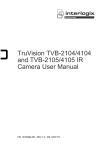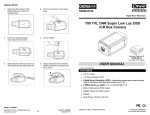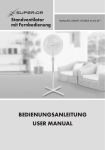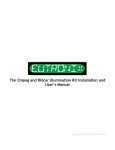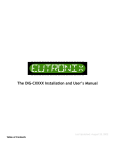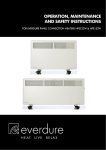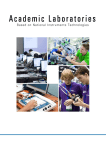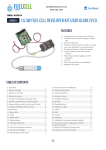Download User Manual The next generation clean energy science education kit
Transcript
User Manual The next generation clean energy science education kit Warning To avoid the risk of property damage, serious injury or death: This kit is intended only for use by persons 12 years old and up, and only under the supervision of adults who have read and understood the instructions provided in the kit’s user manual. Keep children under the age of 12 away as it contains small parts that could be swallowed. The Hydrogen Station generates gases that are very easily ignited. Do not use the Hydrogen Station for any other purpose than refueling the H-racer 2.0 as instructed in this user manual. Keep the Hydrogen Station and H-racer 2.0 away from fire or flame. Read the instructions carefully before use and have them ready for reference. 2. H-racer 2.0 Assembly Instructions WARNING: PLEASE READ CAREFULLY BEFORE STARTING To avoid the risk of property damage, serious injury or death: 1. Read carefully and fully understand the instructions before starting assembly of this kit. 2. This kit is intended only for use by persons 12 years old and up, and only under the supervision of adults who have read and understood the instructions in this user manual. 3. When assembling this kit, tools may be used. Extra care should be taken to avoid personal injury. 4. Some parts are small and fragile: please be careful when handling and connecting parts to avoid breakage. Handle all parts and components with care. 5. Do not attempt to use any part, item, or component provided in this kit for any other purpose than what is instructed in this manual. Do not attempt to disassemble any part, item or component in this kit. 6. The Hydrogen station generates gases that are very easily ignited. Therefore: - Do not use the Hydrogen Station for any other purpose than refueling the H-racer 2.0, as instructed in this user manual. - Keep the H-racer 2.0 and the Hydrogen Station, as well as all items, components and parts contained in this kit away from fire or flame. 7. Keep the solar panel dry. 8. The red & black plugs of the connecting cable are not to be inserted into an AC socket. Battery operation instructions: 1. The removing and inserting of batteries is to be conducted by the adults only. Unscrew the screw holding the battery pack’s cover in place using a screw driver. Once the screw is removed open the battery pack and take out the batteries using your fingers. Do not use a metal object. When inserting the batteries make sure that you are doing so with the correct polarity (the positive end of the battery must match up with the “+” and the negative end of the battery must match up with the “-” sign indicated on the battery pack), close the battery pack and secure its cover by tightening the screw with a screw driver. 2. Non-rechargeable batteries are not to be recharged. 3. Different types of batteries such as rechargeable, alkaline and standard batteries or new and used batteries are not to be mixed and should be used separately. 4. Exhausted batteries are to be removed from the battery compartment. List of parts and components: A. Car chassis B. Hydrogen station C. Car body D. Decoration sticker E. Remote control F. Fuel cell G. Quick connector H. Purging valve I. Refueling input valve J. Syringe K. Front & Rear bumpers L. Three flexible tubes M. Set of 8 screws N. Connector cables O. Solar panel P. Remote control batteries Screwdriver not included Step 1 Connect one of the flexible tubes (part L) to the small purging valve (part H) (see 1A & 1B). Make sure the tube is inserted all the way into the base of the purging valve nozzle. Connect another flexible tube to the nozzle of the refueling input valve (part I) (see 1C & 1D). Make sure the tube is inserted all the way into the base of the nozzle of the refueling input valve. TIP: To fit the flexible tubes onto the nozzle of the valve, connect the tube by twisting it against the nozzle, then push the nozzle into the tube until the tube is snuggly fitted to the base of the nozzle. Step 2 Place the refueling input valve (part I) above the opening on the left side of the chassis (see 2A). Make sure the black cable is above the refueling input valve. Slide the refueling input valve (part I) into its mount located at the opening on the side of the chassis (see 2B). Make sure that the small ridges on the outer edge of the input valve (part I) are positioned at the sides. With a downward motion, click the valve into place ensuring it is smoothly aligned with the outer surface of the chassis. Step 3 Place the purging valve (part H) above the opening on the right side of the chassis (see 3A). Slide the purging valve (part H) into its mount, located at the opening on the side of the chassis. Make sure the refueling valve tube is not in the way of the purging valve. With a downward motion, click the valve into the slot on the chassis. Make sure that the whole body of the purging valve is positioned in the slot on the chassis and the knob is positioned outside of the edge of the chassis (see 3B). Step 4 Place the chassis (part A) on a flat surface. Hold the fuel cell with the nozzle facing upward. Position the fuel cell (part F) onto the square slot located in the middle of the car chassis. The positive mark on the fuel cell should be positioned on the side with the red cable, and the negative mark on the side with the black cable (see 4A & 4B). Push the fuel cell into the chassis. Step 5 Position the black cable terminal between the fuel cell holder and the fuel cell end plate, and position the red cable terminal in the same manner on the opposite side. Make sure the holes are aligned (see 5A). Push the front of the fuel cell into the chassis. Make sure the fuel cell firmly fits into the square opening in the chassis (see 5B). Step 6 Make sure the fuel cell holder is aligned with the two holes on the car chassis. Put the small, short screws (part M) into the screw holes and make sure the screws are entered through the cable terminal holes and straight into the chassis (see 6A). Make sure the red & black cables are not positioned outside the chassis. Please note there are two types of screws. The small one is used for the fuel cell and the bigger one is used for the car body. Use a screwdriver (not included) to attach the fuel cell end plate and the red & black cable terminals to the screw holes on the chassis. Make sure the metal terminals from the cables are closely touching the fuel cell end plates. Do not tighten the screws until the two screws are partially entered into the chassis. Drive the screws into the chassis until no gaps are left between the holder and the chassis. You can ask an adult to help fasten the screws as this requires some force (see 6B). Make sure all the parts are connected tightly without moving. Step 7 Connect one end of the flexible tube (part L) to the lower nozzle on the cylinder and the other end of the flexible tube to the nozzle located nearest to the motor (see 7A ). Step 8 Connect the other end of the flexible tube (part L) on the refueling input valve to the other nozzle located on the fuel cell (see 8A). Make sure the refueling input valve tube is located at the top position. Make sure the tube is inserted all the way onto the base of the nozzle of the fuel cell. Step 9 Arrange the purging valve tube located underneath the tube connecting the cylinder to the fuel cell. (see 9A ). Make sure the tube is inserted all the way to the base of the nozzle of the refueling input valve. Make sure the tubes are not kinked or pinching (see 9B). For correct setup see picture 9B. Warning: Make sure these connections are correct. Any other connection will not be successful to run the car and its fuel cell power system. Also ensure the wires are not touching the wheels and the tubes are not kinked or pinching. Step 10 Place the front bumper (K) onto the bumper frame at the front of the chassis (see 10A & 10B). Step 11 Place the rear bumper (K) onto the bumper frame at the rear of the chassis (see 11A & 11B). Be careful not to place it upside down. Make sure the rear bumper fits correctly onto the frame. Holding the body of the car (part C), place it above the chassis (see 12A & 12B). Step 12 Now it’s time to seal the body of H-racer 2.0! TIP: If you are under the age of 12, it is recommended you ask an adult for help for the following steps: Hold the fully-assembled chassis in your hand and turn it upside down to find 4 small holes near the edges of the chassis and near the 4 wheels. Align the holes on the chassis with the holes on the car body top (see 12C). Use a screwdriver (not included) to attach the body to the chassis using the set of 4 long, bigger screws (part M), and make sure the screws are entered straight into the chassis. Do not tighten the screws until all screws are partially entered into the chassis. Drive the screws into the chassis until no gaps are left between the body and the chassis. Ask an adult to help fasten the screws as this requires some force. To ease this process, you can add a tiny amount of petroleum jelly (not included) inside the screw mounts (see 12D). Step 13 Applying the "H2" sticker (D) on the front hood of the car body Position the car on a flat surface, with the front of the car facing you. Remove the sticker from its backing and position it according to the picture (see 13A). There should be about 1 mm between each side of the sticker and the green stripes on the car body. The sticker should also be placed in the center of the front hood (see 13B). Congratulations! The car is now ready to be fueled with hydrogen! The assembly of your H-racer 2.0 is now completed. 3. Preparing the Hydrogen Station for operation This hydrogen station (part B) can produce tiny quantities of hydrogen on your command, either by using electricity generated by a solar panel (standard solar cell power source included), or 2 AA alkaline batteries (not included). If you are using the solar panel, you must place it in direct sunlight for optimal results. For night time operation or during cloudy weather, the hydrogen station can also use 2 AA alkaline batteries. Placing these batteries inside the hydrogen station is recommended even if you are only using power generated from the solar panel. This enables you to switch from solar "☼" to "ON" direct battery power at any time during refueling, or to accelerate refueling in case of a sudden change in weather. Enabling DC powered operation: Step 1 Open the battery compartment located underneath the hydrogen station by sliding the cover according to the arrow (see A ). Step 2 Place two 1.5V AA alkaline batteries inside the battery compartment as indicated, then close the battery compartment (see B & C). TIP: It is highly recommended to use two AA alkaline batteries. Step 3 Slowly pour water into the water tank opening above the hydrogen station until the water level reaches the top (see D & E). TIP: For optimal operation and longer life of the hydrogen station, use of distilled water is highly recommended. You can purchase distilled water from your local drugstore or pharmacy. Warning: Avoid getting the hydrogen station switch wet. 4. Creating renewable hydrogen using power from the sun Step 1 Attach the back of the solar panel (part O) to its small rectangular support provided in the kit. You can decide to place the solar panel vertically or horizontally depending on how you position the support on the back of the panel. Step 2 Connect the black plug to the black input jack on the solar cell, and the red plug to the red input jack on the solar cell (see 2A). Connect the other end of the red & black plugs to the black input jack of the hydrogen station (see 2B). Warning: Make sure these connections are correct or else this will destroy the hydrogen station. Do not attach an alternative power source that produces over 2.6 Volts. Step 3 Place the solar panel in direct sunlight. Step 4 Switch the hydrogen station to the "☼" sign. The small green lights will now be flashing and you are now producing hydrogen fuel using unlimited power from the sun! You can see you are producing hydrogen when small oxygen bubbles form on the right side of the water tank. Turn the switch off and the hydrogen production will stop. If it is getting dark, or if the sun is not very powerful, or if you want to accelerate refueling time, you can at any time switch the hydrogen station to "ON". In this case hydrogen would be produced using the power of two AA alkaline batteries (not included) placed earlier inside the hydrogen station. TIP 2: During the hydrogen generation process, the bubbles should be continuously coming out from the top right outlet. If the bubbles come out from the water inlet tube at the middle bottom of the water tank, position the tube connected to the syringe at the top right outlet tip of the tube, where the bubbles are released from, and pull the inner container of the syringe towards you. Push out the water in the syringe into the water tank. Repeat this step several times until you see the bubbles come out from the top right outlet (see the picture on the next page). TIP 1: Use the solar panel power option outdoors in direct sunlight, and not in a confined or indoor location. Be sure to turn off the hydrogen station after refueling of the H-racer 2.0 is completed. Another solution is to use a cotton bud (not provided) to block the water inlet, where bubbles come out, until the bubbles come out from the top right outlet. Otherwise the life time and hydrogen generation performance of the electrolyzer cell will be affected. You are now ready to fuel and refuel your H-racer 2.0 using the power of sun a free, clean,renewable and unlimited source of power for the H-racer 2.0. 5. Refueling and operation Use the syringe (part J) to purge the hydrogen storage tank before refueling The H-racer 2.0’s power system only accepts hydrogen as its fuel. If other gases are present, the fuel cell cannot operate and the car will not move. For optimal performance of the H-racer 2.0 the system has to be purged of all the gases within the car. Step 1. Connect a short tube (Part L) to the syringe nozzle. Connect the plastic nozzle of the quick connector (part G) to the tube on the syringe. Make sure the tube is inserted all the way onto the base of the nozzle of the quick connector (see A). Step 2. Connect the other nozzle of the quick connector to the car’s input valve by firmly pressing the quick connector into the car's input valve, and simultaneously turn the quick connector clockwise (see B & C). Step 3. Pull the inner container of the syringe towards you until the balloon shrinks (see C). Step 4. Disconnect the quick connector from the car’s input valve by turning it anti-clockwise quickly and lightly until it pops out from its locked connection. As you disconnect, there is no need to press down the quick connector into the car. For later use of the syringe you have to push down the quick connector on the table to release the gases in the syringe (refer to the picture in the following step 2), meanwhile push the inner container back to the original position to push all the gases out or you can disconnect the tube from the syringe and push all the gases out of it and connect the tube back to the syringe. To refuel the H-racer 2.0 with hydrogen you will need the Hydrogen Station. Step 1 Activate the hydrogen station by switching it to the "ON" position or the "☼" position (switch located behind the Hydrogen Station). You can switch to "ON" if you have added the alkaline batteries inside the hydrogen station or the "☼" position if your hydrogen station is connected to its solar panel. If you are using a solar panel, make sure it is facing strong and direct sunlight. If it is cloudy or if it is night time, you will need to switch to "ON" battery power. Step 2 When the bubbles come out from the upper right tube in the hydrogen station for 10 seconds, it means the hydrogen station is producing hydrogen. Push down the hydrogen station output valve on the table to release the impure gases in the tube to get pure hydrogen (see 2A). Make sure not to push down too hard. Step 3 Connect the hydrogen station’s output valve to the car’s input valve by firmly pressing the syringe’s connector valve into the car's input valve, and simultaneously turning the output valve clockwise (see 3A & 3B). Once the two valves are connected you can let go of the output valve as both valves are now locked into position. TIP: The hydrogen station’s output valve is fragile. If you do not continue to “press in” while you are turning the output valve clockwise, you will risk breaking the output valve. Step 4 Ensure the hydrogen station’s output valve remains connected to the car and the solar panel is also well connected to the hydrogen station if the solar panel is used. (see 4A & 4B) Note: If the small bubbles of oxygen are being released through the middle of the water tank, see troubleshooting section 7. When the Hydrogen Station is activated, hydrogen is being produced by the electrolyzer and released into the hydrogen station's output tube. By completing this essential purging step - you are removing atmospheric gases that have naturally penetrated the car's fuel storage system. The H-racer 2.0’s power system only accepts hydrogen as its fuel. If other gases are present, the fuel cell cannot operate and the car will not move. The purging valve method described below is an important step included to remove all unwanted gases (such as nitrogen) from the car’s hydrogen storage tank, before running operation. Note: Every time before use, the fuel cell could be activated for optimal performance according to the car’s running performance (see page 37). Step 5: When the hydrogen station is producing hydrogen, the cylinder will swell along the wall of the tank, which shows that the balloon is being charged with hydrogen. When the balloon is full, disconnect the outlet from the jack on the side of the car by turning the output valve anti-clockwise quickly and lightly until it pops out from its locked connection. As you disconnect, there is no need to press down the output valve into the car. Turn off the hydrogen station. Note: The LED light will still flash for about 1 minute after the hydrogen station is turned off. TIP: In order to ensure best performance of the car from the second run, charge the cylinder with hydrogen fully after the first operation, press down the purging valve on the side of car and release it quickly to purge the impure gases from the cylinder for keeping the cylinder free of impure gases from the third run (see picture A). Note: Before releasing air out of the balloon by using the syringe, the majority of this air was nitrogen from our atmosphere. Nitrogen will block the hydrogen from reacting with oxygen inside the car’s fuel cell and the car will stop running even if the hydrogen storage tank’s balloon appears to be full . Warning: If you skip this step - the car’s run time will be seriously reduced (see page 29). Note: While the refueling system is locked and operational, and the car's on-board gas storage tank is starting to fill up with pure hydrogen, make sure the switch beneath the car's chassis is at the "off" position. Look carefully at the balloon inside the car's on-board gas storage tank as it starts to move and take shape. It will take at least 2 and a half minutes for the balloon to fill with hydrogen using the direct battery power if the batteries are new. If you are using the solar panel, make sure it is placed in direct sunlight. It will take about 10 minutes in strong sun light for the car's tank to fill up with hydrogen using the standard solar panel included. If the sun is not strong enough, it will either take much longer than 10 minutes, or refueling will not occur at all. Keep the hydrogen station powered until the balloon inside the hydrogen storage cylinder is full. TIP: Expanding the balloon fully within the cylinder may cause the rubber seal to become dislodged. If this happens the system is no longer gas tight and the seal needs to be resecured. Remote control Please refer to the following steps to install the batteries. Step 1: Use the screwdriver (not included) to open the cover of the battery compartment (see A). Step 2: Insert 3 new LR44 batteries (part P) with the correct polarity positions (see B-C). Step 3: Use the screwdriver (not included) to close the cover of the battery compartment. te: 1. Do not mix the used and new batteries or different types of batteries. 2. Batteries are to be inserted with the correct polarity. 3. Exhausted batteries are to be removed from the batteries compartment. 4. Batteries are to be removed if not in use for a long time. Tip: 1. Point the remote control directly towards the car when operating. Obstacles should not be placed between them. The operation range of the remote control is within 5 meters. 2. Replace new batteries when short range of controlling occurs. Activate fuel cell and operation Step 1: Make sure the car switch is on the “off” position. Insert the gas refueling station outlet into the jack on the left side of the car and turn it clockwise tightly to fully charge the balloon and then disconnect the outlet from the gas refueling station. Now the H-racer 2.0 is ready for use. Turn the switch to “on” position. Place the car on the ground for 5 seconds. Step 2: Press the up, down buttons on the remote control to control forward and backward motions of the car. Press the right button to keep the car moving forwards. Press the button located in the middle to keep the car moving backwards.Watch the car go! The car can turn when it moves backwards. If the car runs slowly or can not run with a fully charged balloon, refer to the following step (3). Step 3: Turn the switch to “warm up” position. You can see the green light under the gas storage cylinder flashing. Leave the car until it fully consumes the hydrogen and activates the fuel cell. After the flashing light disappears, turn the switch to the “off” position. (see 3A) Step 4: Repeat step 1 & step 2 to re-start the car in its optimal condition. The on-board fuel cell system will consume hydrogen until the car’s storage tank is almost empty, or until other gases accumulate in the fuel cell. It is estimated that on a full tank and after “warm up” the H-racer 2.0 will run up to several minutes. Once the operation is complete and the balloon is full, make sure you turn the hydrogen station to the “off” position. Note: After the car is used for the first time, impure gases remain in the cylinder. It is suggested that the cylinder should be purged to remove the remaining gases from it. Or before the car runs for the second time, charge the cylinder fully with hydrogen and press down the purging valve to purge the impure gases from the cylinder (see TIP on page 36). So after the car is used for the second time, the balloon in the cylinder is empty. 6. Advice for optimal operation 1. When the hydrogen fills into the hydrogen storage cylinder, the balloon will swell along the wall of the tank, which shows that the balloon has been fully charged with hydrogen. 2. When the car stops running and the balloon in the tank becomes deflated, it shows that the car has run out of hydrogen and needs to be recharged again. 3. The process of activation, charging and purging the remaining gas is applied to improve the fuel cell performance and increase the effective running time. If it runs continuously without conducting the process of activation, charging and purging the excess gas, the car can run, but the run time and speed will be affected. It is suggested that after 2 or 3 times of continuous playing, 10 seconds warm up process be applied. It is also suggested that after 1 or 2 times of continuous playing, the gas purging process be applied. 4. When the car is not used for a long time, remove the batteries from the hydrogen station, pour out the distilled water from the hydrogen filling station, push the purging valve to release the remaining hydrogen in the hydrogen storage cylinder and put them back into the original packaging. Store them in a cool, dry place. 5. Only a clean wet cloth can be used to clean stains on the product surface. Any detergent or chemical material is forbidden. Using water to wash the car or immersing it into water is strongly forbidden 6. Droping the car, collision and extrusion of any parts should be avoided. 7. Troubleshooting 1. The car does not move or runs slower: a. Re-insert the batteries in the remote control or remove the used batteries and insert new batteries into the remote control with correct polarity. b. Turn the switch to “on” position, if it is in the “off” or “warm up” position. c. Activate the fuel cell again. d. Press the purging valve to purge the remaining gases and then charge the hydrogen storage balloon fully again. e. Make sure the wheels are free of obstacles. Point the remote control directly at the car. 2. The car can't turn around or run straightforward: a. Make the front & rear wheels free of obstacles. 3. Short range of controlling: a. Re-insert the batteries in the remote control or remove the used batteries and insert new batteries into the remote controller with correct polarity. 4. The car runs for a short time: a. Charge the car until the balloon in the tank swells fully along the wall of the tank. b. Reduce the frequency of running forward and backward. c. Run the car on a flat surface. d. Activate the fuel cell again or prolong the activation process. e. Charge the car, press the purging valve to purge it, and then re-charge the car again until it is fully charged. 5. The bubbles are appearing slowly in the Hydrogen Station’s water tank: a. If you are using solar panels, make sure the solar panel is in direct sunlight. The solar powered refueling process is generally slower than direct battery power. Therefore it is normal that the bubbles are appearing more slowly in the Hydrogen Station’s water tank. The standard solar cell included with the Hydrogen Station fills the H-racer 2.0 after at least 10 minutes in strong sunlight. b. If you are using the "ON" battery power option and bubbles are appearing slowly, please replace the alkaline batteries inside the Hydrogen Station with new alkaline batteries. c.The Hydrogen Station’s electrolyzer may have dried up as a result of continous use or an extended storage period. In this case find the syringe and leaving the flexible tube attached to the syringe. Push all the air out of the syringe. Position the flexible tube inside the water tank at the tip of the tube where the oxygen bubbles are released from. Use the syringe to suck water out into the syringe container. Watch the tubes inside the hydrogen station closely to make sure water is being “pumped out” into the syringe. This process hydrates the electrolyser and facilitates hydrogen production. Once this is completed, wait 2-3 minutes before operating the hydrogen station again. All should be back to normal! d. If the bubbles are appearing slowly or if there are no bubbles in the Hydrogen Station’s water tank , first add water to the water tank to cover the right top tube tip and then position the tube connected to the syringe at the top right outlet tip of the tube where the bubbles are released from. Pull the inner container of the syringe towards you. Push out the water in the syringe into the water tank. Repeat this step several times until you see the bubbles come out from the top right outlet. e. This problem can also be solved by using a cotton bud (not provided) to block the water inlet in the center of the water tank until the bubbles comes out from the top right outlet. If this is not done the life time and hydrogen generation performance of the electrolyzer cell will be affected. *you can purchase distilled water at your local drugstore or pharmacy. 6. The balloon inside the car's storage tank does not fill up: a. Make sure all the tubes inside the car are well connected and that the output valve of the hydrogen station is well connected to the input valve of the car (press the output valve tightly into the input valve). You may want to unplug and plug the connectors once more to be sure. b. Make sure you filled the Hydrogen Station's water tank with water (distilled water*). c. If all connections are correct and bubbles are released, and the balloon still does not fill up your H-racer 2.0 refueling system may be damaged due to improper use. Do not attempt to repair or fix your H-racer 2.0, contact [email protected] for assistance. d. Remove the used batteries and insert new ones with the correct polarity. 7. The bubbles are appearing from the center of the water tank: a. If the bubbles come out from the water inlet tube at the bottom of the water tank, first add water to the water tank to cover the right top tube tip and then position the tube connected to the syringe at the top right outlet tip of the tube where the bubbles are released from and pull the inner container of the syringe towards you. Push out the water in the syringe into the water tank. Repeat this step several times until you see the bubbles come out from the top right outlet. b. This can also be solved by using a cotton bud (not provided) to block the water inlet where the bubbles are released from until the bubbles comes out from the top right outlet. Otherwise the life time and hydrogen generation performance of the electrolyzer cell will be affected. If you have any further issues contact [email protected] 8. The green LED lights do not flash and no bubbles appear in the Hydrogen Station’s water tank. a. If you are using the included solar panel, check whether the cable connections are correct. If the weather is cloudy or if it is dark, electricity will not be generated and the Hydrogen Station will not operate. In this case, you must switch to “ON” battery power. b. If you are using 2AA alkaline batteries, please check they are correctly inserted into the battery box underneath the Hydrogen Station. If the hydrogen station still does not operate, the batteries may be out of power. Please replace the batteries with new alkaline batteries. c. See troubleshooting section 5. for details on how to “humidify” the electrolyzer. 9. The screws are not fit well in the fuel cell or car chassis screw holes: a. Please note there are two types of screws. The small, short screw is used for screwing the fuel cell and the long, bigger one is used for screwing the car chassis and body. If the screws are mistakely used, the screw holes can be damaged and the screw will not fit well.








































